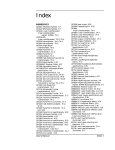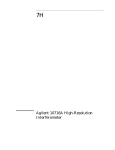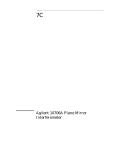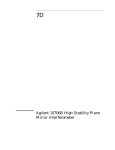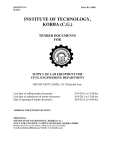Download Chapter 4 System Installation and Alignment
Transcript
4 System Installation and Alignment Chapter 4 System Installation and Alignment Introduction Introduction This chapter provides information to help you install and align an Agilent laser measurement system. Information presented includes: • Pre-installation checklist • Installation of the laser heads and receivers • Installation of optics • Alignment procedures for the different interferometers • Installation and alignment of the wavelength tracker Pre-Installation Checklist In addition to reading chapters 1 through 3 of this manual, complete the following items before installing a laser position transducer into any application. Complete Beam Path Loss Calculation (see the “Beam Path Loss Computation” section in Chapter 3, “System Design Considerations”). If you are using a plane mirror interferometer, you must supply the plane mirror reflector if the Agilent 10724A Plane Mirror Reflector will not work for your installation. See Chapter 7, “Measurement Optics,” in this manual for interferometer descriptions and mirror specifications. See Chapter 9, “Accessories,” in this manual for a description of the Agilent 10724A Plane Mirror. If you are using the Agilent 10715A Differential Interferometer, you must supply an adjustable mount for the reference mirror included with the Agilent 10715A. Determine laser head and interferometer orientation for required direction sensing. (See the Chapter 14, “Principles of Operation,” Chapter 3, “System Design Considerations,” and Chapter 7, “Measurement Optics,” in this manual.) If you are using an Agilent 10719A One-Axis Differential Interferometer or an Agilent 10721A Two-Axis Differential Interferometer, you must supply a suitable mounting arrangement for the interferometer. (See subchapters 7J and 7K for recommendations.) 4-2 User’s Manual Chapter 4 System Installation and Alignment System Grounding If you are using an Agilent 10735A Three-Axis Interferometer, Agilent 10736A Three-Axis Interferometer, or an Agilent 10736A-001 Three-Axis Interferometer with Beam Bender, you must: 1) provide a suitable mounting location that references the interferometer to the stage whose motion is being measured, and 2) make provision for adjusting the laser beam input to the interferometer by translating and turning the beam. Provide for aligning the optics, laser head, and receiver(s) on the machine. Be sure to allow for transmitted beam offset of beam splitters (Agilent 10700A and Agilent 10701A) in your design. See the “Specifications” section in Chapter 6, “Beam-Directing Optics,” of this manual for offset specifications. System Grounding Most Agilent laser systems are grounded through the line cord. For these systems, additional grounding of the chassis is not required, but doing so shouldn’t interfere with normal operation. Refer to system grounding information in Chapter 3, “System Design Considerations,” of this manual. External Cabling The following paragraphs cover all external connections to the laser head and receiver. Each instrument is shipped with a set of color-coded labels. These can be used to label both the cables and their respective rear-panel connectors for easy identification. Laser head cables For use with Agilent 10885A PC, 10889B PC, 10896B VME, 10897B VME, 10898A VME , or N1231A PCI axis board Agilent 10881A/B/C Laser Head Cable (has a DIN for use with the Agilent 10884A Power Supply) The Agilent 10881A/B/C Laser Head Cable connects an Agilent 5517A/5517B/5517C to the Agilent 10885A PC Axis Board, Agilent 10889B PC Servo Axis Board, Agilent 10896B VME Laser Compensation Board, Agilent 10897B VME High Resolution Laser Axis Board, Agilent 10898A VME High Resolution Dual Laser Axis User’s Manual 4-3 Chapter 4 System Installation and Alignment External Cabling Board, or Agilent N1231A PCI Three-Axis Board. The Agilent 10881A/B/C cable is “Y” shaped and has three connectors that are all different as shown in Figure 9-8A. The connectors on the laser head end of the cable and the laser head are “keyed” to go together only one way. The Agilent logo will be “up” on the connector “boot” when the connection is correctly made. The cable connector has locking rings, which take about 1/3-turn clockwise to secure the cable to the mating connector. Agilent 10881D/F/E Laser Head Cable (has spade lugs for use with a power supply other than the Agilent 10884A) The Agilent 10881D/F/E Laser Head Cable connects an Agilent 5517A/5517B/5517C to the Agilent 10885A PC Axis Board, Agilent 10889B PC Servo Axis Board, Agilent 10896B VME Laser Compensation Board, Agilent 10897B VME High Resolution Laser Axis Board, Agilent 10898A VME High Resolution Dual Laser Axis Board, or Agilent N1231A PCI Three-Axis Board. The Agilent 10881A/B/C cable is “Y” shaped and has three connectors that are all different as shown in Figure 9-8B. The connectors on the laser head end of the cable and the laser head are “keyed” to go together only one way. The Agilent logo will be “up” on the connector “boot” when the connection is correctly made. The cable connector has locking rings, which take about 1/3-turn clockwise to secure the cable to the mating connector. The power connector on this cable has three spade lugs for power and ground. Agilent N1251A/B High Performance Laser Head Cable The Agilent N1251A/B High Performance Laser Head Cable connects an Agilent 5517A/B/C/D to the Agilent 10897B VME High Resolution Laser Axis Board, Agilent 10898A VME High Resolution Dual Laser Axis Board, or Agilent N1231A PCI Three-Axis Board. As shown in Figure 9-11, the Agilent N1251A/B cable is “Y” shaped and has three connectors that are all different. The connectors on the laser head end of the cable and the laser head are “keyed” to go together only one way. The Agilent logo will be “up” on the connector “boot” when the connection is correctly made. The cable connector has locking rings, which take about 1/3-turn clockwise to secure the cable to the mating connector. Receiver cables See Chapter 8, “Receivers,” in this manual for installation and alignment information. CAUTION Each connector on the Agilent 10790A/B/C Receiver Cable has both a male and female half. Before making a connection, be sure the male half of the cable connector is properly aligned with the female half of the mating connector. Failure to align the pins prior to mating the connectors may result in damaged pins. 4-4 User’s Manual Chapter 4 System Installation and Alignment External Cabling For use with Agilent 10895A VME Axis Board The Agilent 10790A/B/C Receiver Cable is used to connect the Agilent receivers to the Agilent 10895A VME Axis Board, for both measurement and Wavelength Tracker axes. This cable’s connectors are identical on either end as shown in Figure 9-6. The connectors on the cable and on the receiver and Agilent electronics are “keyed” to go together only one way. The connectors on the cable each have a locking ring, which take a 1/4-turn clockwise to secure the cable to its mating connector. For use with Agilent 10885A PC, 10889B PC, 10896B VME, 10897B VME, 10898A VME , or N1231A PCI axis board Agilent 10880A/B/C Receiver Cable The Agilent 10880A/B/C Receiver Cable is used to connect the Agilent receivers to the Agilent 10885A PC Axis Board, Agilent 10889B PC Servo Axis Board, Agilent 10896B VME Laser Compensation Board, Agilent 10897B VME High Resolution Laser Axis Board, Agilent 10898A VME High Resolution Dual Laser Axis Board, or Agilent N1231A PCI Three-Axis Board, for both measurement and Wavelength Tracker axes. This cable’s connectors are different as shown in Figure 9-7. One connector is a bayonet connector that inserts into the Agilent axis board. The other connector fits the connector on the receiver; this connector is “keyed” to go together only one way. This connector has a locking ring, which takes a 1/4-turn clockwise to secure the cable to its mating connector on the receiver. Agilent N1250A/B High Performance Receiver Cable The Agilent N1250A/B High Performance Receiver Cable is used to connect the measurement signal from an Agilent E1708A or E1709A Receiver to the Agilent 10897B VME High Resolution Laser Axis Board, Agilent 10898A VME High Resolution Dual Laser Axis Board, or Agilent N1231A PCI Three-Axis Board, for both measurement and Wavelength Tracker axes. This cable’s connectors are different as shown in Figure 9-10. One connector is a bayonet connector that inserts into the Agilent axis board. The other connector fits the connector on the receiver; this connector is “keyed” to go together only one way. This connector has a locking ring, which takes a 1/4-turn clockwise to secure the cable to its mating connector on the receiver. User’s Manual 4-5 Chapter 4 System Installation and Alignment Mounting Optics Mounting Optics Adjustable mounts Agilent 10710B and Agilent 10711A Adjustable Mounts provide a convenient means of mounting, aligning, and securely locking in position, the optical components of the laser position transducer (see Figure 4-1). Since both mounts allow some tilt and yaw adjustment, the need for custom fixturing is minimized. These mounts allow the optic being adjusted to be rotated about its optical centerline, simplifying installation. Agilent 10710B Adjustable Mount Agilent 10711A Adjustable Mount Figure 4-1. Agilent 10710B and Agilent 10711A adjustable mounts Both mounts are made of 416 stainless steel. Its magnetic properties can be helpful at the design stage if magnetic clamps are used. However, in final installation, secure the mount with the screws provided. The Agilent 10719A, Agilent 10721A, Agilent 10735A, and Agilent 10736A interferometers do not use adjustable mounts. See Table 7-1 or Table 9-1 for a list of optics that can be used with these mounts. Typical mounting of optics which use adjustable mounts 1. Figure 4-2 shows how to mount the beam splitting and beam bending optics or the single-beam interferometer in the horizontal plane, using the Agilent 10710B Adjustable Mount. 2. Figure 4-3 shows how to mount the beam splitting and beam bending optics or the single-beam interferometer in the vertical plane, using the Agilent 10710B Adjustable Mount. 4-6 User’s Manual Chapter 4 System Installation and Alignment Mounting Optics 3. Figure 4-4 shows how to mount certain linear, plane mirror, or differential interferometers in the horizontal plane, using the Agilent 10711A Adjustable Mount. 4. Figure 4-5 shows how to mount certain linear, plane mirror, or differential interferometers in the vertical plane, using the Agilent 10711A Adjustable Mount. Fasteners All optical components which are designed to be used with an Agilent 10710B or Agilent 10711A Adjustable Mount are supplied with English mounting hardware. The screws supplied with each optical component are those required to mount to its respective adjustable mount. HORIZONTAL PLANE MOUNTING 4-40 Pan Head Screw Agilent #2200-0121 Lock Washer Agilent #2190-0004 Agilent 10710B Adjustable Mount Y T A W TIL Figure 4-2. Horizontal plane mounting using the Agilent 10710B adjustable mount User’s Manual 4-7 Chapter 4 System Installation and Alignment Mounting Optics VERTICAL PLANE MOUNTING Agilent 10710B Adjustable Mount TIL Y A W T 4-40 Cap Screw Agilent #3030-0253 NOTE Yaw Beam Adjustment Limited W YA Agilent 10710B Adjustable Mount 4-40 Pan Head Screw Agilent #2200-0121 Lock Washer Agilent #2190-0004 TIL T Figure 4-3. Vertical plane mounting using the Agilent 10710B adjustable mount 4-8 User’s Manual Chapter 4 System Installation and Alignment Mounting Optics HORIZONTAL PLANE MOUNTING 4-40 Pan Head Screw Agilent #2200-0121 Lock Washer Agilent #2190-0004 Agilent 10711A Adjustable Mount W Always Provide ±1.0mm (±.040") Clearance For Final Lateral Adjustment Y TIL T A Figure 4-4. Horizontal plane mounting using the Agilent 10711A adjustable mount VERTICAL PLANE MOUNTING NOTE Yaw Beam Adjustment Limited. YA W Agilent 10711A Adjustable Mount T TIL o 90 Mounting Hardware. 4-40 Cap Screw Agilent #3030-0253 Figure 4-5. Vertical Plane Mounting Using the Agilent 10711A Adjustable Mount User’s Manual 4-9 Chapter 4 System Installation and Alignment Aligning Optics Aligning Optics General When installed in a positioning system, any transducer must be aligned to ensure correct operation and minimum measurement error. The major objectives in aligning the laser system are: 1) maximizing the measurement signal at the receiver, and 2) minimizing cosine error. In general, 1. the measurement signal at the receiver is maximized by aligning the optics to center the laser beam on the receiver input, and 2. cosine error is minimized by aligning the laser beam in the measurement axis parallel to the motion of travel. Figure 4-6 shows a measurement axis where the laser beam is aligned parallel to the mechanical motion of travel of the retroreflector and centered on the receiver. OPTIMUM ALIGNMENT Reference Beam Retroreflector Laser Beam Receiver Interferometer Measurement Beam Figure 4-6. Optimum alignment The receiver photodetector only measures the overlapping portion of the laser beams. For maximum signal, the interferometer and retroreflector are aligned so the reference beam from the interferometer and the measurement beam from the retroreflector exactly overlap upon recombination. These recombined laser beams then enter the receiver in the center of the lens aperture. From Figure 4-6, it is clear that if the recombined laser beams entering the 4-10 User’s Manual Chapter 4 System Installation and Alignment Aligning Optics receiver are not centered on the photodetector, measurement signal loss will occur. If the interferometer or the retroreflector are misaligned (Figure 4-7), the reference and measurement beams no longer completely overlap, resulting in signal loss. OPTICS MISALIGNMENT Reference Beam Retroreflector Laser Beam Receiver See View A–A Reference Beam Measurement Beam Measurement Beam Receiver Detects Only Overlapped Portion View A – A Figure 4-7. Effect of optics misalignment Typically, a lateral offset of 1/4 of the beam diameter between the beams is allowable for an adequate measurement signal. However, you must make every effort to optimize the laser beam overlap for maximum performance. If the measurement beam is not aligned parallel to the direction of retroreflector travel, there are two effects. First, a cosine error is generated of a magnitude directly related to the angle of misalignment. (For a complete description of cosine error, see Chapter 15, “Accuracy and Repeatability,” in this manual.) Second, when movement occurs between the optics, the angular misalignment also causes a lateral displacement of the measurement beam with respect to the reference beam at recombination, resulting in additional signal loss. Figure 4-8 illustrates the result of angular misalignment. User’s Manual 4-11 Chapter 4 System Installation and Alignment Aligning Optics ANGULAR MISALIGNMENT Laser Axis Reference Beam Retroreflector Position 1 Retroreflector Position 2 Laser Beam Receiver Interferometer Measurement Beam Travel Axis Figure 4-8. Effects of angular misalignment to the direction of travel NOTE The presence of measurement signal through the total length of travel does not guarantee that the measurement axis is aligned for minimum cosine error. Also, any angular misalignment of the laser beam to the direction of travel causes a decrease in the measurement signal strength. Alignment principles Before beginning any alignment procedure, you should understand the basic principles. The following information summarizes the various factors that affect the optical alignment of the laser system. While performing the alignment procedure, keep in mind: 1. In order to achieve maximum accuracy, the laser beam must be parallel to each axis of travel. 2. For most systems, start the alignment at the laser head and move out one component at a time until the last component on an axis is aligned and the laser beam impinges on the receiver aperture. The exception to this principle will be systems using an Agilent 10719A, Agilent 10721A, Agilent 10735A, or Agilent 10736A interferometer; these are “referenced” interferometers, whose design and construction allows them to be installed in specified fixed locations relative to the measurement mirrors with which they will be used. For these systems, it will be necessary to provide adjustment of the laser beam relative to the interferometer, since the interferometer itself is not adjustable. 4-12 User’s Manual Chapter 4 System Installation and Alignment Aligning Optics 3. The angular direction of the beam can be aligned by moving the laser head or adjusting a beam bender. 4. The reflected beam can be aligned by adjusting a beam splitter or interferometer. 5. The angular direction of the beam will not be changed by adjusting a retroreflector. Similarly, the angular direction of a beam transmitted straight through a beam splitter or interferometer will not be changed by adjusting that component. NOTE There will be up to a 30-arc-minute deviation of the beam when it passes through any interferometer except the Agilent 10702A-001, Agilent 10719A, Agilent 10721A, Agilent 10735A, Agilent 10736A, or Agilent 10766A. (See the “Specifications” information in the appropriate subchapter of Chapter 7 in this manual for specifications.) 6. The retroreflectors (also called cube corners) do not change the angular direction of the beam. However, they do displace the beam and reverse its direction. The laser beam remains parallel to its original path. In the case of the Agilent 10705A Single Beam Interferometer reference cube-corner and the Agilent 10704A Retroreflector, the displacement is zero because the beam hits the center of the cube-corner (when properly aligned) 7. On multiaxis configurations, the first axis to be adjusted is the axis whose angular adjustment of the laser beam requires adjustment of the laser head. After the first axis is aligned, the laser head is locked down and any angular adjustment of the laser beam in the other measurement axes is accomplished by rotating the optical components. 8. Properly aligned interferometers exhibit less sensitivity to temperature. See “Deadpath Error” in Chapter 15, “Accuracy and Repeatability,” of this manual for details. 9. Set up multiaxis systems with all legs of the laser beam orthogonal to each other and to the measurement mirrors. For ease of optical layout and alignment, you should keep the laser beams horizontal or vertical. 10. Define all beam legs (plane and direction) against machined surfaces known to be parallel or perpendicular to the stage plane. Use an auto reflection mirror with square sides (e.g., a metrologist’s “true square”). 11. Before installing the optics, define all beam bends (location and angle) with an optical square (Agilent 10777A) or pentaprism. This ensures the best possible starting point for the final adjustment of the laser system optics. User’s Manual 4-13 Chapter 4 System Installation and Alignment Receiver Alignment and Gain Adjustment The remainder of this chapter has these major parts: 12. Receiver alignment and gain adjustment procedure, which is common to all measurement axes. 13. A discussion of the two major alignment methods: autoreflection and overlapping dots. 14. Specific alignment techniques for each type of interferometer. Receiver Alignment and Gain Adjustment See Chapter 8, “Receivers,” in this manual for this information. There are two basic alignment techniques used with a laser measurement system: 1) Autoreflection, and 2) Overlapping Dots. Autoreflection is the more accurate method, and is always preferred. Autoreflection should always be used: 1) for short travel applications, 2) measurements where cosine error must be reduced to the absolute minimum possible, and 3) when plane mirror reflectors are used. Overlapping Dots is a satisfactory method in applications involving relatively long travel. In general, regardless of the technique used, alignments are performed with all optical components in place. Autoreflection Method Summary The autoreflection method of alignment is recommended for all applications, especially those having less than 0.5 meter (20 inches) travel. It is based on the principle of aligning a reflecting surface normal to the direction of travel and aligning the laser beam perpendicular to this reflecting surface (that is, parallel to the direction of travel) to minimize cosine error. This technique is fast and is the best way to eliminate cosine error. The principle steps used for the “Autoreflection” method of alignment are given below. A detailed autoreflection alignment procedure for a specific configuration of optics follows the autoreflection method and the overlapping dots method summaries. 1. Mount the laser head and optics in the desired locations and align the laser beam roughly parallel to the axes. 2. Provide a reflector, aligned perpendicular to the axis of travel. Place the reflector between the interferometer and retroreflector. 4-14 User’s Manual Chapter 4 System Installation and Alignment Autoreflection Method Summary NOTE Typical reflectors having required mirror flatness and referenced sides for autoreflection are: • True Square • Other precision angle plates or squares with a gage block wrung to the appropriate surface. The mirrored surface should be perpendicular to its sides (or angle plate) within 15 arcseconds. Typical means for aligning the mirrored surface perpendicular to the axis of travel are: • Locating the mirror reference surfaces against fixed reference surfaces on the machine’s positioning system (e.g., ways, rails, guides). (See Figure 4-9.) • Measuring the reference surfaces on the mirror, true square, or gauge block with a dial indicator, and adjusting the pitch and yaw of the mirror surface. (See Figure 4-11.) USING REFERENCE SURFACES TO ALIGN MIRROR Guide Rails Stage True Square (Reference Mirror) Mirrored Surface Figure 4-9. Using reference surfaces to align mirror User’s Manual 4-15 Chapter 4 System Installation and Alignment Overlapping Dots Method Summary 1. Place the perpendicular reflector at the far end of travel. 2. Select the small aperture on the laser head by rotating the front turret. 3. Adjust the laser beam so that the beam is reflected by the reflector back upon itself. Alignment is complete when the (small) return beam is centered on the small aperture of the laser head. This adjustment of the laser beam can be performed by moving the laser head, beam bender or interferometer, depending on the optical layout. Overlapping Dots Method Summary The overlapping dots alignment method uses the principle that if the measurement beam to the retroreflector is not parallel to the direction of travel, it is offset upon recombination with the reference beam of the interferometer (see Figure 4-10). When motion occurs between the retroreflector and interferometer along the measurement path, any angular misalignment causes a displacement (at the receiver) of one laser beam with respect to the other which can be visually observed. Since the human eye can resolve a displacement of the beam of approximately 300 micrometers (0.01 inch), this technique can be applied to reduce cosine error for measurement travel of 0.5 meter (20 inches) or longer. For travel less than this, the sensitivity of this technique is normally not sufficient and autoreflection should be used. Cosine error (E), in parts per million (ppm), can be calculated from the following formula: 2 S E = ---------2 8D Where D is the distance measured in millimeters (inches) and S is the lateral offset of the returning beam in micrometers (thousands of an inch). For example, if the distance measured is 600 mm and this results in an offset of the return beam of 1.2 mm (1200 µ) then: 2 ( 1200 ) E = -------------------------------- = 0.5ppm , 0.5 micrometer per meter of travel 2 ( 8 ) × ( 600 ) 4-16 User’s Manual Chapter 4 System Installation and Alignment Overlapping Dots Method Summary The following are the principle steps used for the “Overlapping Dots” method of alignment, followed by a detailed alignment procedure for a specific configuration. 1. Mount the laser head and optics in their desired locations. 2. Select the small beam aperture on the laser head. 3. With the optics as close together as possible, adjust any component (laser head, interferometer, or retroreflector) to get the dots (reference and measurement beams) to overlap at the receiver. NOTE Placing a piece of translucent tape over the receiver lens will help in observing the incident beams. MEASUREMENT BEAM DOT MOVEMENT Retroreflector Position 1 fV Retroreflector Position 2 fH fH Receiver fH Interferometer Displaced Measurement Beams Travel Axis Laser Axis Figure 4-10. Measurement beam dot movement 4. Move the retroreflector away from the interferometer. If the laser beam is not parallel to the axis of travel, the measurement beam dot will begin to move away from the reference beam dot. The dot will move until the beam is cut off by the edge of the interferometer’s aperture. Stop moving the retroreflector before the beam is thus blocked, or when the end of travel is reached. Figure 4-10 shows why the measurement dot moves. 5. Figure 4-11 illustrates a typical two-dot pattern on the receiver that is seen after the optics have moved. Now rotate the beam until the dots again overlap at the receiver. This adjustment of the laser beam can be done by moving the laser head, beam bender, or interferometer, depending on the optical layout. NOTE Lateral movement of either the laser head or interferometer may also be necessary to achieve alignment. User’s Manual 4-17 Chapter 4 System Installation and Alignment Aligning the Agilent 10702A Linear, Agilent 10766A Linear, and Agilent 10705A Single Beam Interferometers RESULTS OF REFLECTOR MOVEMENT Reference Dot Measurement Dot Agilent 10780C Receiver Figure 4-11. Results of reflector movement Aligning the Agilent 10702A Linear, Agilent 10766A Linear, and Agilent 10705A Single Beam Interferometers The alignment techniques for the linear and single-beam interferometers are nearly the same. Both use a retroreflector (cubecorner) as the measurement reflector. Either the Autoreflection or the Overlapping Dots method may be used to maximize return measurement signal power and to minimize cosine error. The Autoreflection method is always preferred because it is more accurate. It must be used for measurement distances less than 0.5 meter (20 inches) and is strongly recommended for distances over 0.5 meter. The Overlapping Dots method should only be used when the measurement distance is over 0.5 meter. The choice of method used depends on convenience and the nature of the application. The goal for both of these alignment methods is to have the reference and measurement beams be coincident at the receiver throughout the measurement. 4-18 User’s Manual Chapter 4 System Installation and Alignment Aligning the Agilent 10702A Linear, Agilent 10766A Linear, and Agilent 10705A Single Beam Interferometers Alignment aids (for Agilent 10702A, Agilent 10766A, Agilent 10705A) To help in aligning these interferometers, an alignment aid is included with each. They are: • For Agilent 10702A and Agilent 10702A-001—Alignment target (Agilent Part Number 10702-60001). See Figure 4-12. • For Agilent 10766A—Alignment target (Agilent Part Number 10767-60001). See Figure 4-12. • For Agilent 10705A—Alignment Target (Agilent Part Number 10705-60001). See Figure 4-12. These alignment aids are magnetic, to simplify positioning them on the interferometer. They are used on the input side of the interferometer to properly position the beam. ALIGNMENT AIDS TARGET REMOVE IGNMENT AFTER AL echnolo Agilent T gies Alignment Target P/N 10702-60001 echnolo Agilent T gies Alignment Target P/N 10705-60001 Alignment Aid P/N 10767-67001 Figure 4-12. Linear and single-beam interferometer alignment aids User’s Manual 4-19 Chapter 4 System Installation and Alignment Aligning the Agilent 10702A Linear, Agilent 10766A Linear, and Agilent 10705A Single Beam Interferometers Autoreflection alignment procedure (for Agilent 10702A, Agilent 10766A, Agilent 10705A) This procedure describes the autoreflection alignment method used on a two-axis system. Figure 4-13 shows a measurement setup similar to Figure 4-14(A) except that the referenced mirrors (true squares) are included. Steps 1 through 11 constitute the X-axis autoreflection alignment procedure. NOTE 1 With all optical components in place, install the alignment targets on the interferometer and the receiver (Figure 4-14, position 1). Place a piece of opaque material, such as frosted tape, in front of the retroreflector. 2 With the laser beam passing through the 50% beam splitter, adjust the laser head and interferometer until the laser beam enters one hole of the alignment target and exits the other to hit the receiver alignment target centered on the hole over the photodetector. This is the reference beam that hits the receiver. NOTE AUTOREFLECTION ALIGNMENT Y-Axis Retroreflector Reflector Alignment Aid (P/N 10706-60001) Indicator Beam Bender Y-Axis Single Beam Interferometer Y-Axis Receiver Voltmeter Indicator Test Point Laser 50% Beam Splitter X-Axis Receiver X-Axis Linear Interferometer X-Axis Retroreflector Reflector Figure 4-13. Autoreflection alignment 4-20 User’s Manual Chapter 4 System Installation and Alignment Aligning the Agilent 10702A Linear, Agilent 10766A Linear, and Agilent 10705A Single Beam Interferometers 3 Place a referenced mirror (true square) between the interferometer and retroreflector so that the measurement beam from the interferometer hits its reflective surface. (See Figure 4-13.) Align the referenced mirror (true square) with a precision indicator until its reflective surface is perpendicular to the direction of travel. (See Figure 4-13.) 4 Turn the front turret of the laser head to select the small aperture. NOTE If the distance between the laser head and the reflector is 0.5 meter (20 inches) or more, the formula given above in the paragraph on Overlapping Dots determines the cosine error based on the offset of the return beam at the laser head. For example, a distance between the laser head and reflector of 0.5 meter and an offset of the return beam at the small aperture of the laser of 500 microns (0. 0202 inch) gives a cosine error of approximately 0.12 ppm. 5 Pitch and yaw the laser head until the beam reflects back on itself from the referenced mirror (true square) and is centered on the small aperture of the laser head. Slight side-to-side movements of the interferometer may be required to ensure that the reference beam from the interferometer is centered on the receiver alignment target. NOTE For high-accuracy alignment or for installations where there is less than 0.5 meter (20 inches) between the laser head and reflector, perform steps 6 through 8. 6 Remove the receiver alignment target and interferometer alignment target and select the large aperture of the laser head. 7 With a fast-responding voltmeter (preferably an analog type) attached to the receiver test point and receiver case ground, pitch and yaw the laser beam (laser head or interferometer on this axis) until a signal is received on the receiver. (The voltmeter will suddenly jump to some value greater than 0.25 volt.) This is a critical adjustment and may initially require great care. 8 Adjust the laser beam in pitch and yaw to get the maximum voltmeter reading (which may be fluctuating). Now carefully readjust the interferometer until the voltage reading suddenly drops back down to about 0.3 volt. NOTE The alignment should be adjusted such that the voltage reading from the receiver test point occurs just below the sudden jump up in voltage. If the alignment is fixed to sustain this peaked voltage, system operation will be degraded. User’s Manual 4-21 Chapter 4 System Installation and Alignment Aligning the Agilent 10702A Linear, Agilent 10766A Linear, and Agilent 10705A Single Beam Interferometers This procedure will align the laser beam to within ±1.2 arcminutes of the direction of travel, resulting in a cosine error of approximately 0.05 ppm. That is 0.05 micron per meter of travel (0.05 microinch per inch) of cosine error. 9 Fasten the laser head and interferometer securely, preserving the alignment. Remove the referenced mirror (true square) and the opaque material. 10 Reposition the retroreflector until the return measurement beam is centered on the receiver alignment target and overlaps the reference beam from the interferometer. NOTE Placing a piece of translucent tape over the receiver lens will help in observing the incident beams. 11 Verify that the receiver’s LED is ON and the voltage at the receiver test point is between 0.6 and 1.3 Vdc (for 10780C/F), or 1.5 and 8.0 Vdc (for E1708A), or 1.8 and 10.0 Vdc (for E1709A). NOTE Steps 12 through 22 constitute the Y-axis autoreflection alignment. 12 Pitch and yaw the 50% beam splitter until the reflected laser beam is centered on the beam bender aperture. Slight side-to-side adjustments of the 50% beam splitter may be necessary to ensure there is no beam clipping. Fasten the 50% beam splitter securely. 13 Adjust the beam bender until the reflected beam is centered on the aperture of the single-beam interferometer. The single-beam interferometer alignment target can be used as an aid and then removed. Fasten the beam bender securely. 14 Place the receiver alignment target on the receiver and rotate the turret of the laser head to select the small aperture. 15 Place a referenced mirror (true square) between the interferometer and the retroreflector so that the measurement beam from the interferometer strikes its reflective surface. Align the referenced mirror with a precision indicator until its reflective surface is perpendicular to the direction of travel in both angular axes (arcseconds). 16 Place a single-beam interferometer alignment aid on the output side of the interferometer and adjust the single-beam interferometer in pitch and yaw until the beam 1) reflects back on itself and 2) is centered on the small aperture of the laser head. Slight side-to-side movement of the interferometer may be required to ensure that the reference beam 4-22 User’s Manual Chapter 4 System Installation and Alignment Aligning the Agilent 10702A Linear, Agilent 10766A Linear, and Agilent 10705A Single Beam Interferometers from the interferometer is still centered on the receiver alignment target. Do not adjust the laser head. NOTE For high-accuracy alignment or for installations where there is less than 0.5 meter (20 inches) between the laser head and reflector, perform steps 17 through 19. 17 Remove the receiver alignment target and interferometer alignment target and select the large aperture of the laser head. 18 With a fast-responding voltmeter (preferably an analog type) attached to the receiver test point and receiver case ground, pitch and yaw the laser beam (laser head or interferometer on this axis) until a signal is received on the receiver. (The voltmeter will suddenly jump to some value greater than 0.25 volt.) This is a critical adjustment and may initially require great care. 19 Adjust the laser beam in pitch and yaw to get the maximum voltmeter reading (which may be fluctuating). Now carefully readjust the interferometer until the voltage reading suddenly drops back down to about 0.3 volt. NOTE The alignment should be adjusted such that the voltage reading from the receiver test point occurs just below the sudden jump up in voltage. If the alignment is fixed to sustain this peaked voltage, system operation will be degraded. This will align the laser beam to within ±1.2 arcminutes to the direction of travel, resulting in a cosine error of approximately 0.05 ppm. That is 0.05 micron per meter of travel (0.05 microinch per inch) of cosine error. 20 Fasten the single-beam interferometer and beam bender securely, making sure the alignment is preserved. Remove the reflector (true square). 21 Adjust the retroreflector until the return measurement beam is centered on the receiver and overlaps the reference beam from the interferometer. NOTE Placing a piece of translucent tape over the receiver lens will help in observing the incident beams. 22 Verify that the receiver’s LED is ON and the voltage at the receiver test point is between 0.6 and 1.3 Vdc (for 10780C/F), or 1.5 and 8.0 Vdc (for E1708A), or 1.8 and 10.0 Vdc (for E1709A). User’s Manual 4-23 Chapter 4 System Installation and Alignment Aligning the Agilent 10702A Linear, Agilent 10766A Linear, and Agilent 10705A Single Beam Interferometers Overlapping dot alignment procedure (for Agilent 10702A, Agilent 10766A, Agilent 10705A) This subsection describes the overlapping dots alignment method used on a two-axis configuration. Figure 4-14 is a typical measurement configuration which includes a linear interferometer and a single-beam interferometer. NOTE Steps 1 through 10 constitute the X-axis “Overlapping Dot” alignment procedure. 1 Place the interferometer alignment target on the laser side of the X-axis interferometer and place the receiver alignment target on the receiver so that it is not in the laser beam (see Figure 4-14, position 1). Place a piece of opaque material such as frosted tape between the interferometer and retroreflector. 2 With the retroreflector and interferometer at the closest point, adjust the laser head until the laser beam 1) passes through the 50% Beam Splitter, 2) enters one hole of the alignment target on the interferometer, and 3) exits the other hole to hit the receiver alignment target centered on the hole over the photodetector. A slight lateral adjustment of the interferometer or laser head may be required. 3 Remove the opaque material from between the retroreflector and interferometer and rotate the receiver alignment target to position 2 (see Figure 4-14). 4 Adjust the retroreflector to center the return measurement beam on the receiver alignment target. 5 Move the retroreflector to its furthest point of travel. 6 Pitch and yaw the laser head to center the return beam on the receiver alignment target. 7 Return the retroreflector to the point closest to the interferometer. 8 Repeat steps 4 through 7 until the return beam is centered on the receiver alignment target at both ends of travel. A lateral offset of 500 microns over a 0.5 meter travel is equal to a cosine error of 0.12 ppm or 0.12 micron per meter of travel (0.12 microinch per inch). 4-24 User’s Manual Chapter 4 System Installation and Alignment Aligning the Agilent 10702A Linear, Agilent 10766A Linear, and Agilent 10705A Single Beam Interferometers OVERLAPPING DOT ALIGNMENT Y-Axis Retroreflector Beam Bender Y-Axis Single Beam Interferometer Voltmeter Y-Axis Receiver Test Point Laser 50% Beam Splitter X-Axis Receiver X-Axis Retroreflector X-Axis Linear Interferometer A. Alignment Schematic Laser Beam Receiver Alignment Target Position 2 Interferometer Alignment Target Receiver Alignment Target Position 1 To Interferometer Receiver From Interferometer B. Alignment Target for Interferometer C. Alignment Target for Receiver Figure 4-14. Overlapping dot alignment 9 If the reference beam returning from the interferometer is not centered on the receiver target, adjust the interferometer until both the reference and the measurement beams are centered. NOTE In step 10, make sure the alignment is not disturbed. User’s Manual 4-25 Chapter 4 System Installation and Alignment Aligning the Agilent 10702A Linear, Agilent 10766A Linear, and Agilent 10705A Single Beam Interferometers 10 Lock the laser head and X-axis optics down securely. Remove the receiver alignment target. Verify that the LED indicator on the receiver is lighted and that the voltage at the receiver test point is between 0.6 and 1.3 Vdc. NOTE Steps 11 through 20 constitute the Y-axis “Overlapping Dot” alignment procedure. 11 Place the alignment target on the Y-axis single-beam interferometer and on the Y-axis receiver. Place a piece of opaque material between the single-beam interferometer and the retroreflector. 12 Pitch and yaw the 50% beam splitter until the reflected laser beam is centered in the beam bender entrance aperture. Slight lateral adjustments of the 50% beam splitter may be necessary to ensure there is no beam clipping. Fasten the 50% beam splitter securely. 13 Adjust the beam bender until the reflected beam is centered on the alignment target installed on the single-beam interferometer. Fasten the beam bender securely in place. 14 With the single-beam interferometer and retroreflector at their closest points, adjust the single-beam interferometer until the reference beam is centered on the receiver alignment target. Remove the opaque material. 15 Adjust the Y-axis retroreflector until the measurement beam is centered on the receiver alignment target. 16 Move the retroreflector to its furthest point of travel. 17 Pitch and yaw the single-beam interferometer to center the return beam from the retroreflector on the receiver alignment target. When aligning the single-beam interferometer, it may also be necessary to make slight lateral adjustments to ensure that the reference beam from the single-beam interferometer is also centered on the receiver alignment target. 18 Return the retroreflector to the point closest to the single-beam interferometer. 19 Repeat steps 15 through 18 until the return beam from the retroreflector is centered on the receiver alignment target at both extremes of travel. Secure the single-beam interferometer, preserving the alignment. 4-26 User’s Manual Chapter 4 System Installation and Alignment Aligning the Agilent 10702A Linear, Agilent 10766A Linear, and Agilent 10705A Single Beam Interferometers 20 Remove the single-beam alignment target and the receiver alignment target. Verify that the receiver’s LED is ON and the voltage at the receiver test point is between 0.6 and 1.3 Vdc (for 10780C/F), or 1.5 and 8.0 Vdc (for E1708A), or 1.8 and 10.0 Vdc (for E1709A). User’s Manual 4-27 Chapter 4 System Installation and Alignment Aligning the Agilent 10702A Linear, Agilent 10766A Linear, and Agilent 10705A Single Beam Interferometers Product specifications and descriptions in this document subject to change without notice. Copyright (C) 2002 Agilent Technologies Printed in U.S.A. 07/02 This is a chapter from the manual titled: Laser and Optics User's Manual For complete manual, order: Paper version: p/n 05517-90045 CD version: p/n 05517-90063 This chapter is p/n 05517-90104 4-28 User’s Manual





























